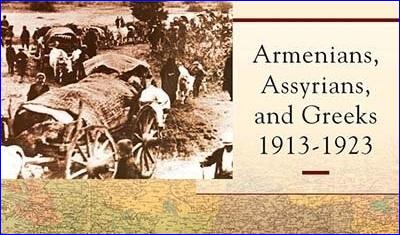


The book is a result of an academic conference held on May 10-11, 2013 and hosted by the prestigious Illinois Holocaust Museum and Education Center in Skokie, Illinois (AINA 2013-05-18).
Related: The Assyrian Genocide
According to the editor, when "one sees what is happening in Turkey right now, how Turkey is dealing with its own minorities, the type of language that the President of Turkey is using in regards to non-Muslim Europe, it all reflects the same narrow, ethno-religious nationalism that prevailed there 100 years ago. It is being used today by the President of Turkey to mobilize masses to fulfill his political objectives. In fact, the non-Muslim groups combined, including Armenians, Assyrians, Greeks, and Jews, now make up only around 100,000 of Turkey's population, as opposed to 4.5 million in Ottoman Turkey before the Genocide."
The final years of the Ottoman Empire were catastrophic ones for its non-Turkish, non-Muslim minorities. From 1913 to 1923, its rulers deported, killed, or otherwise persecuted staggering numbers of citizens in an attempt to preserve "Turkey for the Turks," setting a modern precedent for how a regime can commit genocide in pursuit of political ends while largely escaping accountability. While this brutal history is most widely known in the case of the Armenian genocide, few appreciate the extent to which the Empire's Assyrian and Greek subjects suffered and died under similar policies.
The Young Turks believed that a policy of "Turkey for Turks" would solve their political problems, thus they adopted an ultra-ethnic, nationalist attitude towards non-Turks. "This attitude may be compared to the attitude of ISIS today. Driven by extreme Sunni radical Islamic nationalism, they draw on religious fanaticism and use it to stir up those who are susceptible to kill Christians, Yezidis, and even other Muslims who are not Sunni," says Shirinian.
This comprehensive volume is the first to broadly examine the genocides of the Armenians, Assyrians, and Greeks in comparative fashion, analyzing the similarities and differences among them and giving crucial context to present-day calls for recognition.
It is also one of the rare books which investigates the fate of the Ottoman Christian people during World War I as a whole, as not only Armenians, but Greeks and Assyrians were also targeted by the genocide carried out by the Young Turk's Ottoman Government. In the shadow of World War I, the Young Turk's aim was to exterminate the entire Christian population.
Citing the US Ambassador to the Ottoman Empire, Henry Morgenthau, "The Armenians are not the only subject people in Turkey which have suffered from this policy of making Turkey exclusively the country of the Turks. The story which I have told about the Armenians I could also tell with certain modifications about the Greeks and the [As]syrians. Indeed, the Greeks were the first victims of this nationalizing idea ... It was probably for the reason that the civilized world did not protest against these deportations that the Turks afterward decided to apply the same methods on a larger scale not only to the Greeks but to the Armenians, [As]syrians, Nestorians, and others of its subject peoples.
In his introduction, Shirinian sheds light on the reasons why the history of the genocide was not studied considering the fate of all Christians groups as whole and as an integral part of the Ottoman history.
ISBN 978-1-78533-432-0 $69.95/£49.00
Published February 2017
Following the introduction by Shirinian, the book contains 14 chapters prepared by notable genocide scholars, including three by Assyrians, followed by an extensive bibliography and index.
Contents
Introduction by George N. Shirinian
PART I: CONTEXTS
- Chapter 1. The Background to the Late Ottoman Genocides; George N. Shirinian
- Chapter 2. Convulsions at the End of Empire: Thrace, Asia Minor, and the Aegean; Dikran Kaligian
- Chapter 3. Assyrians in the Ottoman Empire and the Official Turkish Policy of Their Extermination, 1890s-1918; Anahit Khosroyeva
PART II: DOCUMENTATION AND EYEWITNESS ACCOUNTS
- Chapter 4. Considering Genocide Testimony: Three Case Studies; Paul Bartrop
- Chapter 5. The Assyrian Issue 1914-1935: Australian Documents and Press; Stavros Stavridis
- Chapter 6. American Women, Massacres, and the Admiral: Deep in Anatolia during the Turkish Nationalist Revolution; Robert Shenk
- Chapter 7. Found in Translation: Eyewitness Accounts of the Massacres in Nicomedia as Reported by Greek Journalist Kostas Faltaits; Eleni Phufas
- Chapter 8. The Destruction of Smyrna in 1922: An Armenian and Greek Shared Tragedy; Tehmine Martoyan
PART III: LEGACIES AND INTERPRETATIONS
- Chapter 9. Lemkin on Three Genocides: Comparing His Writings on the Armenian, Assyrian and Greek Genocides; Steven Leonard Jacobs
- Chapter 10. The Ottoman Genocide of the Armenians and Greeks: The Similarities and Structural Peculiarities; Gevorg Vardanyan
- Chapter 11. The Genocide of the Ottoman Greeks 1913-1923: Myths and Facts; Thea Halo
- Chapter 12. Redeeming the Unredeemed: The Anglo-Hellenic League's Campaign for the Greeks in Asia Minor; Georgia Kouta
- Chapter 13. Genocide by Deportation into Poverty: Western Diplomats on Ottoman Christian Killings and Expulsions, 1914-1924; Hannibal Travis
- Chapter 14. The Socio-Psychological Dimension of the Armenian Genocide; Suren Manukyan

or register to post a comment.